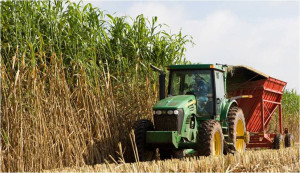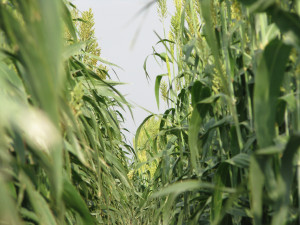College Station, Texas, USA
July 7, 2015
Production costs of bioenergy crops such as sorghum have kept it from growing into a secure, sustainable source of energy. But a new project led by a Texas A&M AgriLife Research sorghum breeder is aimed at changing that.

A bioenergy sorghum crop is harvested near College Station. (Texas A&M AgriLife Research photo)
AgriLife Research, along with Carnegie Mellon University, was recently awarded $3.1 million in funding from the U.S. Department of Energy’s Advanced Research Projects Agency-Energy.
A major challenge for energy crop breeding programs is the lack of methods to effectively phenotype all of the traits that might directly influence biomass yield and composition, said Dr. Bill Rooney, AgriLife Research plant breeder in College Station and lead researcher for the project.
“An understanding of these traits and their role in productivity is essential to increasing the rate of gain from energy-crop breeding programs,” Rooney said.
He said the DOE funding will be used to develop and deploy an automated phenotyping system. This high-throughput plant phenotyping technology, along with transformational modeling and machine-learning approaches, will significantly increase the rate of genetic improvement for biomass yield and resilience.

Biomass yield is an important trait for bioenergy sorghum. (Texas A&M AgriLife Research photo)
DOE’s Transportation Energy Resources from Renewable Agriculture program, or TERRA, was established to support the creation of transformational energy technologies and systems.
“The development of an innovative robotic phenotyping system will allow us as breeders to collect massive amounts of useful data that is impractical to do with manpower,” Rooney said. “Those measurements are needed to establish a comprehensive set of plant traits that will then allow us to produce and distribute into commercial channels energy sorghum hybrids with increased biomass yields.”
He explained the goal of automated discovery is to create a system that automatically provides recommendations to the breeder using the available sensor data, genetic information and expert knowledge. The main decisions during automated discovery are which parents to cross and how many of the offspring to plant given the constraints.
The AgriLife Research sorghum-breeding program developed commercially feasible hybrid sorghum systems for grain and forage sorghum in the 1950s and, in partnership with Ceres Inc., led the commercialization of first-generation energy sorghum hybrids in the 2000s, he said.
The extensive sorghum germplasm base already in place will be used to evaluate and capitalize on the effectiveness of the proposed technology. The Carnegie faculty will develop and deploy the robotic platforms and sensors in AgriLife Research experimental sorghum germplasm. Both groups will analyze and interpret the data and share results.
The scientists hope to be able to increase the rate of genetic improvement of energy sorghum, thereby doubling the biomass yield of energy sorghum within 15 years and enabling the U.S. to produce cost-competitive biofuels from bioenergy crops.
Rooney said while this research is focused on bioenergy sorghum, the technology is deployable to a range of biomass crops as well as agronomic row crops. The technology and knowledge gained from the project can be leveraged to improve other grass bioenergy crops such as switchgrass, Miscanthus, energycane and poplar.
“We believe the successful implementation of this TERRA project will contribute to sustainable, cost-competitive large-scale production of biofuels from lignocellulosic feedstocks and the technology developed could also enhance production of food, feed and forage.
“This will significantly increase U.S. energy security, reduce energy-related emissions of greenhouse gas, enhance rural economies and create technologies and a framework of analysis that could benefit other biogeographical studies,” he said.